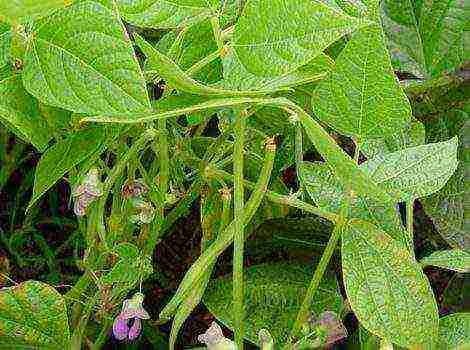Content
Peach is a short-lived plant... It is distinguished by its rapid entry into the fruiting phase, intensive growth.
Peach buds have the ability to quickly awaken and release young shoots. The crown grows and if it is not thinned out, starting from the second year, then the yield will decrease.
From the fourth year, the peaches will become small and misshapen. Young trees begin to bear fruit in the second year after planting. With good care, they can give a crop in the first year, with autumn planting.
But this should not be allowed. Better to let the plant develop. You will collect a small crop, but time will be spent, and the plant will lose its strength.
Table of contents
- Juicy peach variety
- Varieties and their description
- Ripen early: Kiev Early, White Swan, Grisborough and Redhaven, Morettini
- Medium ripening: Collins, Cardinal, Golden Moscow, Sibiryak, Saturn, Kremlin, Donskoy
- Late, frost-resistant: Fury, Frost, Veteran
- Self-fertilized, self-fertile peaches: Inka, Vulcan, Harnas, Golden Jubilee
Juicy peach variety
In the past, gardeners dreamed of peaches that can be grown in all regions of the country, not just in the south.
Today, their dreams have come true: breeders have developed many interesting winter-hardy, frost-resistant varieties with different fruiting times, fruit shapes and taste.
Peach trees are divided into four groups (depending on the shape of the fetus):
- Real peach is a plant with pubescent fruits.
- Nectarine or bare peach.
- Potanin's Peach (Potanin's Almond).
- Fergana peach or fig (flattened fruit).
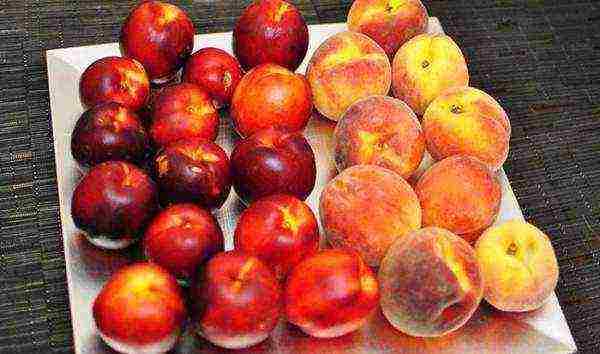 Peach trees are divided into four groups depending on the shape of the fruit.
Peach trees are divided into four groups depending on the shape of the fruit.
The timing of fruit ripening, the flowering period - it all depends not only on the area where the tree is grown, but also on the characteristics of the variety:
- Early maturing varieties give off the first fruits from July to August.
- Mid-season enter the fruiting phase in early August and delight with the harvest until September.
- Late peaches ripen in autumn: September, early October.
Which variety is best suited for a plot or garden depends on the climatic features of the area. It is important to choose plants so as to stretch the fruiting season for the whole season.
The yield of the plant depends on the correct choice of the variety. When buying a seedling, you need to pay attention to several important points, we give their description:
- Where did the seedling come from?... If the nursery is located in a different strip, then the seedling may die in the first year after planting or it will constantly freeze. The variety should be zoned, and the nursery should be in the same climatic zone (preferably even in the same region) where the tree will grow.
- Inspection of the scion site... It should be smooth and even, without bumps and hardened juice.
- Plant root system should have a fibrous shape. A root in one trunk is not good.
Annual seedlings take root better and delight with the harvest faster. When buying, it is better to focus on them, but choose strong, healthy plants, and not frail twigs.
Varieties and their description
Ripen early: Kiev Early, White Swan, Grisborough and Redhaven, Morettini
The peculiarity of early maturing varieties is that they quickly enter the fruiting phase. Two-, three-year-old seedlings are already producing a small harvest.Yields peak in the fourth to fifth year after planting.
When choosing early maturing varieties, it is better to focus on plants that have a low, spreading crown. They are easier to care for and shape during the growth period. Shorter trees are also easier to harvest.
Among the representatives of this group, varieties deserve special attention Kiev Early, White Swan and Redhaven.
Redhiven's crop peaks at 11 years of age. More than a hundred kilograms of fruit are harvested from one tree.
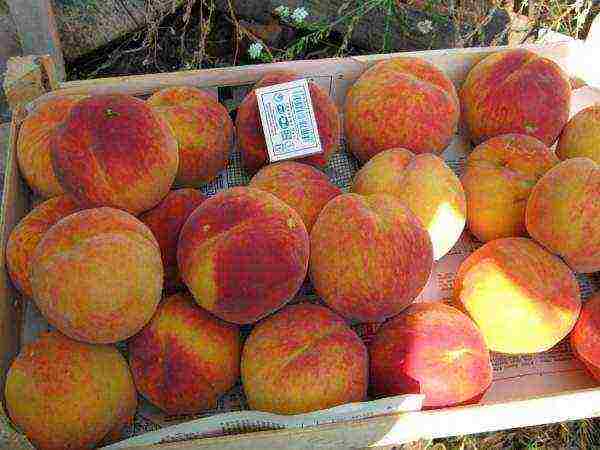 The best early varieties of peaches: Kievsky Early, White Swan, Grisboro and Redhaven, Morettini
The best early varieties of peaches: Kievsky Early, White Swan, Grisboro and Redhaven, Morettini
Each variety of early peach is good in its own way and has a lot of advantages.
Benefits of early peach varieties:
- form a wide crown no more than 5 meters high;
- plants bloom in April-May;
- they enter the fruiting phase quickly: in the fourth year after planting the seedling;
- fruiting is extended from July to August;
- it has a high yield, aromatic and tasty fruits.
The first fruits appear on a mature, well-formed tree. This cannot but affect the yield: from a six-year-old tree, with proper care, up to 60 kilograms of peaches can be harvested.
Another prominent representative of this group is Grisborough variety... It is distinguished by medium vigor, but, unlike the aforementioned varieties, it has an average winter hardiness.
In order for the plant to bear fruit in mid-latitudes, it must be planted in calm places.
High winter hardiness pleases peach moretini... One of its advantages is a spreading crown that is easy to shape.
Morettini fruits are among the first to ripen, but they have average transportability. This prevents the fruit from being transported over long distances.
Medium ripening: Collins, Cardinal, Golden Moscow, Sibiryak, Saturn, Kremlin, Donskoy
Medium ripening varieties allow the peach conveyor to continue.
Feature of plants of this species:
- high, spreading crown (from 5 meters);
- high productivity;
- good winter hardiness;
- large fruits.
Mid-season peaches have a huge number of varieties, but among them there are several types that show themselves perfectly in any conditions and do not require special care: Collins, Cardinal, Golden Moscow, Siberian, Saturn, Kremlin.
Variety Cardinal famous for its huge fruits (from 140 g) and excellent taste. This is one of the most delicious types of peach. On the international tasting scale, he received five points. This is the highest mark.
The plant is resistant to diseases, but it is difficult to tolerate recurrent frosts. It is better to plant it in a calm place, not far from the wall of a house or fence, but away from water.
 The best varieties of peaches of medium ripening: Collins, Cardinal, Zolotaya Moskva, Sibiryak, Saturn, Kremlevsky, Donskoy
The best varieties of peaches of medium ripening: Collins, Cardinal, Zolotaya Moskva, Sibiryak, Saturn, Kremlevsky, Donskoy
Kremlin peach adapts without problems to changes in temperature conditions, has high winter hardiness. Thanks to this, he attracted the attention of gardeners from regions where summers are cool. With good care, the fruits reach up to 200 g.
Variety Golden Moscow not so long ago appeared on the market, but its seedlings are very popular. The plant winters well and is resistant to diseases, has juicy large fruits.
The fruiting period stretches for almost three weeks. Peach blooms late, after the threat of frost return, and this increases the number of quality fruits.
Sibiryak variety highly regarded by farmers for its excellent transportability. The yellow fruit can be stored in a cold room for up to three weeks. In addition, they are tasty and juicy, and the bone is easily separated from the pulp.
The first crop is harvested in August, and the last fruits are removed in early September.
Peach Saturn stored no longer than 12 days. It's also a lot. The plant has high winter hardiness (up to -27). A strong crown complicates care and this affects the yield.
If the branches are tilted downward, then you can get an excellent harvest every year.
The most winter-hardy representative of this group is peach donskoy... It not only withstands severe frosts, but also quickly recovers after freezing.
The main advantage of peaches of the middle ripening period is high yield, transportability of fruits and excellent winter hardiness of the tree.
Most varieties have a juicy pulp and a pleasant aroma.... A high crown can be regarded as a disadvantage, but with the correct shaping of the tree, it is easily eliminated and turns into a virtue.
Late, frost-resistant: Fury, Frost, Veteran
Planted a peach, but it does not bear fruit, only intensively increases the crown? Do not be upset: it is better to be patient and wait a little longer.
Late-ripening varieties bear fruit starting at the age of 5 after planting a seedling. They are intended for cultivation in the southern regions. In the North and in the Middle zone, they do not have time to ripen and are sour.
American Fury withstands frosts down to -28 degrees. It is valued for its huge, up to 300 g, orange-colored fruits. The plant is undemanding to care.
The collection of fruits falls in September, when only apple and pear trees are left in the garden. The fruits are stored for no longer than six days.
Frost variety also bred by American breeders, who focused on winter hardiness and large-fruited plants.
The tree gives a high stable yield, withstands frosts down to -26 degrees, and is resistant to diseases. The fruits are used for fresh food. Stored for ten days.
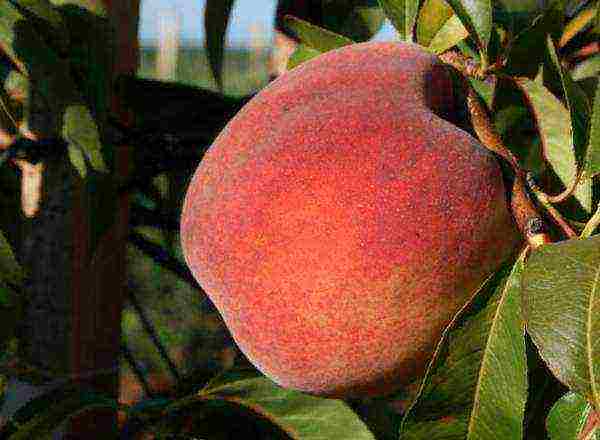 The best late-ripening peach varieties: Fury, Frost, Veteran
The best late-ripening peach varieties: Fury, Frost, Veteran
Veteran grade differs from late-ripening varieties in that it quickly enters the fruiting phase and has a low growth. The size of the fruit is also not impressive (no more than 150 g).
They love it for its good taste. It is ideal for conservation.
Self-fertilized, self-fertile peaches: Inka, Vulcan, Harnas, Golden Jubilee
Self-pollinated varieties are very popular among gardeners. To increase fruiting, recommend planting several plants for cross-pollination... But one tree will also bear fruit.
Among self-pollinated, self-fertile varieties, a good harvest in a single planting gives Inka, Volcano, Harnas, Golden Jubilee.
Harnas belongs to winter-hardy, early-ripening dessert varieties. It is a vigorous tree that bears fruit regularly. Its peculiarity is that the fruits hold tightly to the branches and do not fall off.
Early maturing varieties are distinguished by high winter hardiness of trees and flower buds. They can withstand recurrent frosts. This makes it possible to grow them not only in the southern latitudes, but also in the middle lane, as well as in Siberia and the Urals.
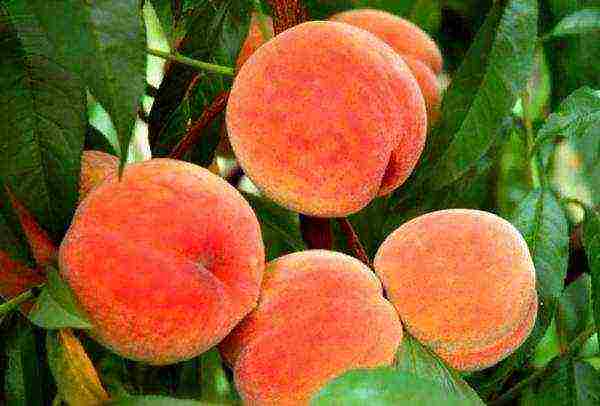 Self-pollinated peach varieties: Inka, Volcano, Harnas, Golden Jubilee
Self-pollinated peach varieties: Inka, Volcano, Harnas, Golden Jubilee
In the regions of Siberia, it is necessary to protect trees from recurrent frosts.
Mid-season varieties build up a decent crown and only then please with a rich harvest. The disadvantage is that it is difficult to form branches, but a regular and generous harvest allows you to turn a blind eye to this.
Mid-season varieties often bent downward to facilitate harvesting.
The lack of late-ripening varieties isthat they can only grow in a certain area. But if the climatic conditions allow, then these trees will not only decorate the garden, but also delight with delicious fruits.
When planting a peach, it should be borne in mind that all varieties bloom very early, when there are still few pollinating insects. You can help the plant by gently shaking the upper branches so that the pollen falls on the lower inflorescences.
Plants respond well to feeding and watering... Water plays an important role in the formation of fruits. Its quantity depends not only on the size of peaches, but also on their taste and aroma.
Give your seedlings a little attention and care so that they can turn into beautiful trees and please with the harvest every year.
The most popular and most suitable peach varieties for the central and northern regions of Ukraine are in our review:
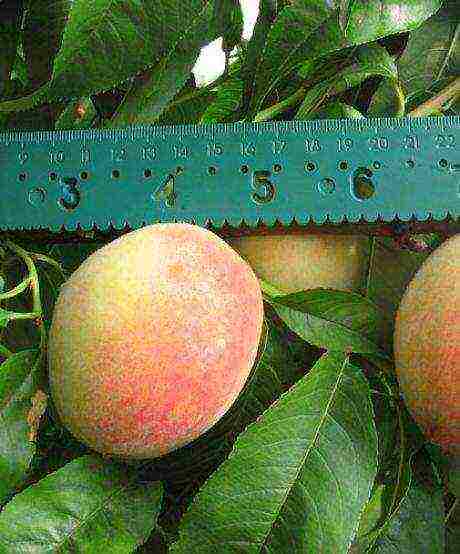 Peach varieties for the Center and North of Ukraine
Peach varieties for the Center and North of Ukraine
Variety Forest-Steppe *. The tree is of medium vigor. Fruits are of medium size, weighing 90-110 g, large 120-150 g, rounded-oval, slightly flattened on the sides. The main color is light cream, the blush in the form of strokes and dots occupies almost the entire fruit. The skin is dense, slightly separated from the pulp, with medium pubescence. The pulp is white, juicy, sweet and sour, of high taste, it separates well from the stone. Ripening time - mid-July - early August. Productivity - 30-50 kg per tree.
0 0
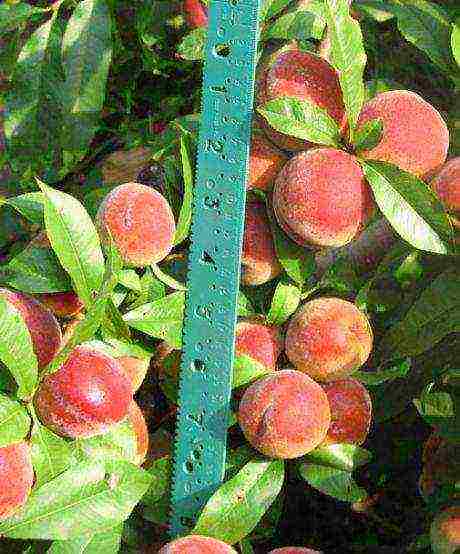 Peach varieties for the Center and North of Ukraine
Peach varieties for the Center and North of Ukraine
Variety Oksamytovy *. The tree is of medium growth, with a spreading crown. Fruits are medium, weighing 60–70 g, rounded, creamy with a carmine blush that takes up almost the entire fruit. The pulp is white-creamy, juicy, sweet, of high taste, freely separates from the stone. Ripening time - early August. Productivity - 30-50 kg per tree.
0 0
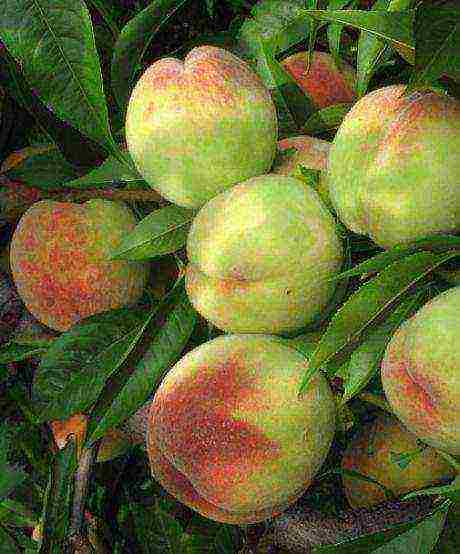 Peach varieties for the Center and North of Ukraine
Peach varieties for the Center and North of Ukraine
Variety Gift of Kiev *. The tree is of medium vigor. Fruits are large, rounded, with an average weight of 130–150 g. The skin is thin, tender, lagging behind the pulp, with slight pubescence, white-cream, with pink and dark red blush in the form of dots and continuous strokes up to almost half of the fruit. The pulp is white, juicy, sweet and sour, of high taste, freely separates from the stone. The ripening time of the fruits is the end of July - the first decade of August. Productivity - 30-50 kg per tree.
0 0
 Peach varieties for the Center and North of Ukraine
Peach varieties for the Center and North of Ukraine
Rumyany * grade. The tree is vigorous, with a spreading crown. Fruits are round, large, weighing 110–130 g, some up to 150 g. The color is creamy yellow, with a dotted blush, which occupies almost the entire fruit, the blush is most pronounced on the illuminated side. The pulp is creamy white, pale pink near the stone, very juicy, fragrant. Fruit ripening time is the first half of August.
0 0
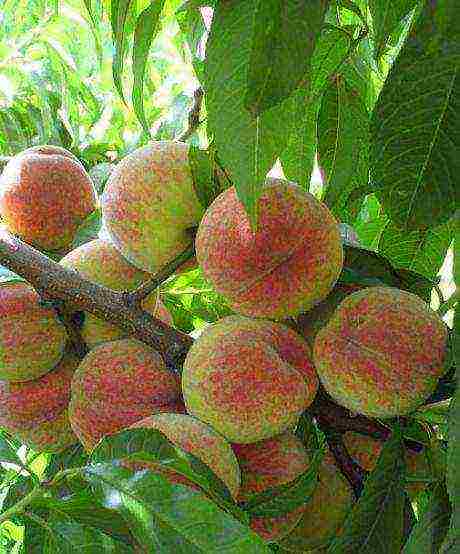 Peach varieties for the Center and North of Ukraine
Peach varieties for the Center and North of Ukraine
Druzhba grade *. The tree is vigorous, with a spreading or slightly flat crown. Fruits are round, large, with an average weight of 140–160 g, sometimes 200–250 g. The main color is creamy yellow, with a blush. The pulp is whitish-creamy, juicy, sweet, of high taste, easily separates from the stone. The fruits of the average ripening period are mid-August. Differs in increased winter hardiness.
0 0
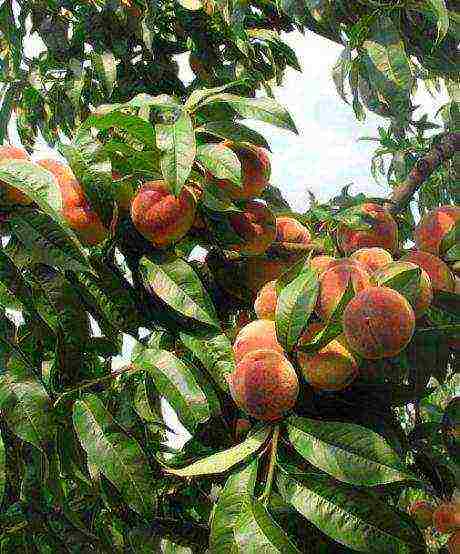 Peach varieties for the Center and North of Ukraine
Peach varieties for the Center and North of Ukraine
Variety Generous *. A tree of medium vigor with a spreading crown. Flowers are pink-shaped. The fruits are large, weighing 100–120 g, round in shape with a dark pink blush. The abdominal suture is not very pronounced. The skin is easily separated from the pulp. The pulp is white, juicy, sweet and sour, of high taste. The stone is medium, rounded with a pronounced point, easily separated from the pulp. Ripening time is the first half of September. The yield is high, 35-50 kg per tree.
0 0
 Peach varieties for the Center and North of Ukraine
Peach varieties for the Center and North of Ukraine
Variety Memory Shevchenko *. Medium-sized tree. Fruits are oval, slightly compressed on the sides, of medium size, weighing 70–100 g. The main color is whitish-cream, with a blurred blush. The pulp is white, juicy, of high taste, easily separates from the stone. Fruit ripening time is mid-August. Productivity - 30-50 kg per tree.
0 0
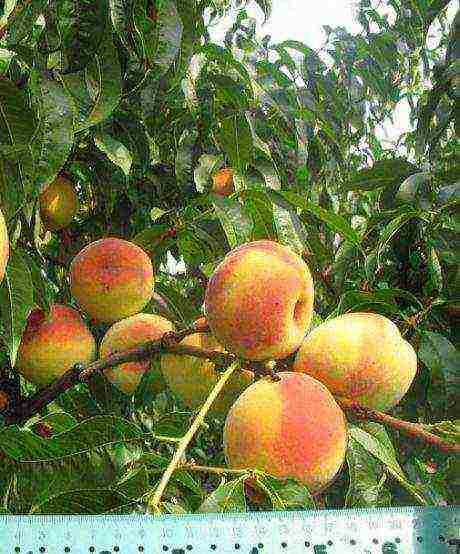 Peach varieties for the Center and North of Ukraine
Peach varieties for the Center and North of Ukraine
Variety Slavutich *. A tree of medium growth, with a spreading crown. Fruits are medium and large, weighing from 80 to 140 g, rounded, slightly compressed on the sides. Abdominal suture of medium depth. The fruit is yellow with a bright blush. The skin is tender, medium pubescent, easily removable from the fruit. The pulp is yellow, juicy, of high taste. Fruit ripening time is mid-August. Productivity - 30-50 kg per tree. Plants are characterized by increased winter hardiness.
0 0
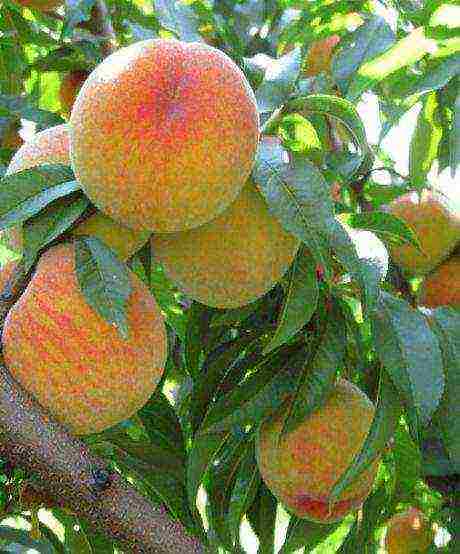 Peach varieties for the Center and North of Ukraine
Peach varieties for the Center and North of Ukraine
Variety Lyubimets *. The tree is of medium vigor.Fruits are large, weighing 150–170 g, oval, with medium pubescence. The cover color is yellow-cream, with a dark pink blush in the form of streaks and spots, occupies a third of the fruit. The skin is firm, of medium thickness, easily separated from the pulp. The pulp is yellow, juicy, with a noticeable sourness, high taste. The bone is easily separated from the pulp. The yield is high, 50-60 kg per tree. The fruits ripen in the second half of August.
0 0
 Peach varieties for the Center and North of Ukraine
Peach varieties for the Center and North of Ukraine
Variety Kievsky Nectarine *. The tree is of medium vigor. Fruits are round, of medium size, weighing 60–80 g, with a smooth skin, yellow-orange, with a bright blush in the form of strokes and dots, which occupy almost the entire fruit. The pulp is orange, with red veins near the stone, sweet, juicy, with pleasant acidity, of high taste. The bone is semi-detached from the pulp. Fruit ripening time is the first half of August. Productivity - 20-30 kg per tree. The variety is transportable.
0 0
 Peach varieties for the Center and North of Ukraine
Peach varieties for the Center and North of Ukraine
Redhaven variety. Fruits average weight 140-150 g. Skin with velvety pubescence, medium thickness, dense, easily removed from the fruit. The color is orange-yellow, with a carmine-burgundy blurred, as well as point, weakly streaked and slightly marbled blush. The pulp is orange-yellow, pink near the stone, medium and low fiber, tender, juicy, with a strong aroma, excellent taste. The fruits ripen on average, in the 2nd decade of August. The variety is quite winter-hardy and resistant to late spring frosts.
0 0
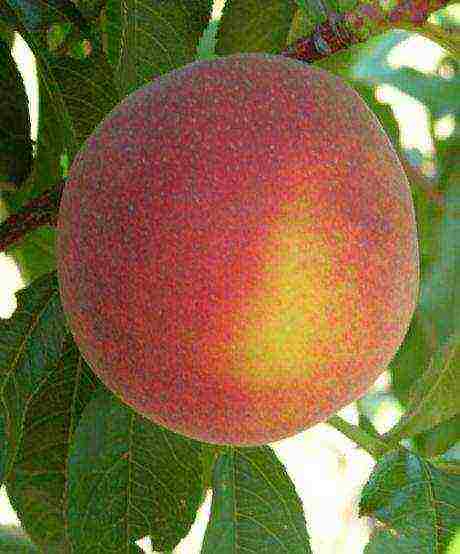 Peach varieties for the Center and North of Ukraine
Peach varieties for the Center and North of Ukraine
Variety Ambassador of Peace. The tree is medium-sized, with a rounded spreading crown. On all types of shoots, buds are abundantly laid, which requires normalizing pruning. Fruits are round, medium, weighing 160 g. Color - yellow-carmine. The pulp is yellow, dense, with a pleasant harmonious taste. The stone is large, it is difficult to separate from the pulp. The yield is high. The fruits ripen in mid-August. Possesses increased winter hardiness of flower buds and stable high yield.
0 0
* Varieties of the selection of the National Botanical Gardens. N. Grishko NAS of Ukraine.
HOME ARTICLES SCHOOL OF GARDENING Popular varieties of peach in Ukraine
|
Peter Mazur , Head of Research Laboratory
horticulture and viticulture NESC , Kiev
Godun Variety of average ripening period of the selection of the Institute of Horticulture (author A.P. Rodionov). Differs in high field resistance to curliness, forms a thickened spherical crown. Fruits are large (150 g), round, slightly pubescent, yellow in color with a juicy yellow pulp of a pleasant refreshing taste, the bone is poorly separated from the pulp. The variety has a moderate yield - even after a mild winter, more than 12 kg from one tree were not obtained. The harvest ripens on August 15-20. VETERAN HYBRID No. 13
Hryvnia A promising hybrid form of a peach. It begins to bear fruit in the 2-3rd year after planting, it is very resistant to curliness and powdery mildew.The fruits are large (80-90 g), yellow, completely covered with a striped blurred blush. The pulp is yellow, juicy, aromatic, tender, of excellent taste. Ripens in early September. After the harsh winter of 2006-2007, "Hryvnia" bore fruit. DONETSKY YELLOW KIEVSKY EARLY FOREST-STEPPE Representative of the selection of the National Botanical Garden named after N.N. Grishko NAS of Ukraine. Differs in high and stable productivity, winter hardiness, moderately affected by powdery mildew. The tree is medium-sized, with a spreading crown, bears fruit mainly on last year's growth, requires careful cyclic pruning. Fruits are medium (90-110 g), rounded-oval, slightly compressed on the sides. Ripens in the second decade of August. It is used in breeding as a donor of winter hardiness and high taste. IN MEMORY OF RODIONOV AMBASSADOR OF PEACE The variety is resistant to spring frosts, generously lays flower buds. The fruits are large (160 g), very beautiful, high quality (4.8 points). The pulp is yellow, rather dense. The bone is not separated well. The fruits begin to ripen from mid-August. REDGOLD American breeding nectarine. Recently, it is widespread in Western Europe due to its high resistance to adverse conditions and valuable economic traits. It blooms in early May, which reduces the likelihood of damage by spring frosts. Extremely decorative during flowering due to its dark cherry blossoms. Fruits are large (100-160 g), oval in shape, covered with a bright cherry blush on most of the skin, undisturbed, dessert taste, the stone separates well from the pulp. Harvest "Redgold" ripens in the 20th of August. Compared to other nectarines, it is slightly rotted. Flower buds can withstand temperatures down to -25 ° C. REDHAVEN One of the most popular foreign varieties of peach not only in the north of Ukraine, but also in the world. The tree is distinguished by rather strong growth, large (100-160 g) fruits of a rounded shape, the skin is golden yellow, with a bright striped blush on the larger surface of the fruit. The pulp is yellow, juicy, of high taste, the bone is freely separated from the pulp. In the conditions of Kiev, the harvest ripens in mid-August. STARK SANGLO FAVORITA MORETTINI A variety of Italian selection of early ripening. The trees are medium-sized, begin bearing fruit in the third year, and have an average winter hardiness. Fruits are medium-sized (80 g), rounded, orange-red in color with a striped blush. The pulp is yellow, slightly fibrous, of good sweet and sour taste, the bone does not separate from the pulp. The fruits ripen in the second decade of July and are used mainly fresh. FLAVERTOP HAROU DIAMONT An early ripe variety of Canadian breeding peach, grown in Ukraine only because flower buds can withstand frosts down to -26-28 ° C. The tree is vigorous, has a spreading crown, thickens strongly, and therefore requires significant pruning. Fruits of medium size (100-120 g) are oval in shape, the skin is light yellow, covered with a blurred blush. The pulp is slightly orange with a pleasant sweet and sour taste. The harvest ripens at the end of July. On our site you can also read about peaches: published in the magazine "Neskuchny Sad" No. 5 2010 print version
|
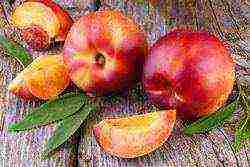 Peach is the most large-fruited horticultural crop among the fairly common stone fruit plants, and nectarine has competed with it quite recently. The cultivation of these fruit crops in Ukraine allows you to get a fast-growing and fruitful plant, which has such positive qualities as self-fertility and good productivity. Nectarine and peach in Ukraine show not only a high level of survival, but also a very good yield.
Peach is the most large-fruited horticultural crop among the fairly common stone fruit plants, and nectarine has competed with it quite recently. The cultivation of these fruit crops in Ukraine allows you to get a fast-growing and fruitful plant, which has such positive qualities as self-fertility and good productivity. Nectarine and peach in Ukraine show not only a high level of survival, but also a very good yield.
The best varieties
It should be remembered that peaches are the most thermophilic, least winter-hardy and fastest growing plants, and carefully choose a variety taking into account the characteristics of the growing region. In Ukraine, twenty varieties of peach and several varieties of nectarine, including late and early ones, have been zoned.
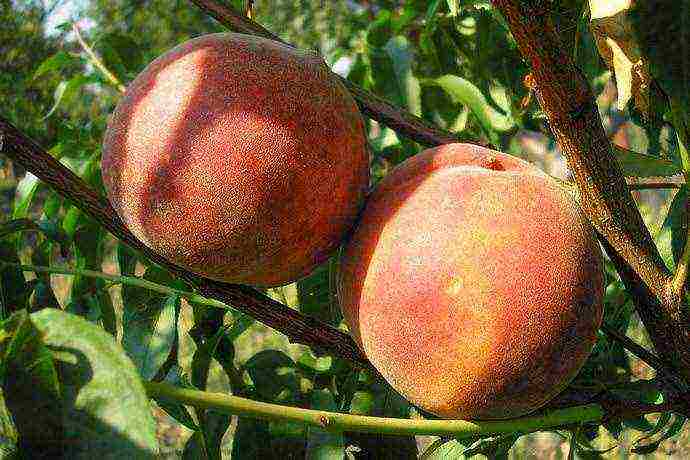
Popular varieties of peach
For the south, varieties should be selected whose characteristics and descriptions declare the presence of such qualities as decent yield, resistance to the main, most common diseases and pests.
| Peach variety name | Wood | Crown | Fruit | Pulp | The ripening period of the crop |
| "Golden Jubilee" | Tall, strong enough, begins bearing fruit in the third year | Spreading | Large, weighing up to 125-135 g, oval, golden yellow with tan | Orange-yellow color, with good firmness, delicate and fibrous, quite juicy, with aroma | Medium ripening |
| "Kiev early" | Medium height, with a good level of winter hardiness | Rare, wide and pyramidal | Medium in size, weighing 90 g, round-elongated, beige-yellow, with a tan | Greenish-white color, with good juiciness and pleasant taste | End of july |
| "Red-cheeked" | Medium height, with good winter hardiness | Average in terms of thickening, not too spreading | Large, weighing 120-130 g, broadly oval, with a green-creamy surface and a bright tan | Green-white color, moderate fiber, juicy and tasty | Mid-early ripening |
| "Kremlin" | With high vigor and high productivity | Wide oval and slightly spreading | Medium size, weighing 170 g, roundish, yellow-orange in color with a tan | Yellow-orange, with fibrous and medium density. Sufficiently juicy and aromatic | Medium ripening |
| "Rosy" | Vigorous plant with thick and vigorous annual shoots | Sprawling and attractive crown | Rounded, large, weighing 125 g, with a pronounced abdominal seam, thin-skinned, creamy yellow | Creamy white color, with sufficient juiciness and aroma | Mid-early |
| "Soviet" | Medium plant with medium winter hardiness | Spherical and very easy to clean crown | Relatively large, weighing 140-145 g, dull-oval in shape, with a greenish-yellow surface and tan | Yellow in color, with delicate fiber, juicy and aromatic | First half of August |
| "Juicy" | Vigorous and with sufficient winter hardiness | Average in terms of thickening, not too spreading | Weighing 152-165 g, wide-oval shape, greenish-cream color with tan | White or greenish-cream in color, with medium fiber, juicy and aromatic | Early ripening |
Popular varieties of nectarine
Nectarines are somewhat less popular with Ukrainian gardeners. The best are nectarine varieties that demonstrate high quality indicators and a stable annual yield.
| Nectarine variety name | Wood | Crown | Fruit | Pulp | The timing of the ripening of the crop |
| "Red gold" | Medium and very productive | With average spreading rates | Rounded-spherical, with a dark red blush, large, weighing up to 215 g | Dense and juicy, with medium fiber. | Mid late |
| Fleming Fury | Medium vigor with good yields | Average spreading | Large, with a red blush, ovoid or spherical in shape | Yellow in color, with good juiciness and delicate fiber. | First decade of August |
| "Flavon" | Vigorous plant with excellent yield and decent frost resistance | Sufficiently compact and easy to clean | Rounded oval, with a seam, yellow with a red blush | Medium gravity, juicy and aromatic | Mid late |
| "Rebus" | Medium and very vigorous plant with good productivity | Average spreading | Large, spherical, weighing at least 185-195 g | Thick, sweet, delicate and aromatic | Mid-early |
| "Alitop" | Vigorous plant with excellent yield and decent frost resistance | Represented by powerful branches, needs rationing | Rounded-oblong, symmetrical, with a pronounced bright blush | Yellow in color with red veins, juicy and tasty | Mid late |
Features of planting seedlings
High-quality varietal seedlings in fruit nurseries must meet the following requirements:
- well-developed and powerful enough root system;
- absence of delamination and damage to the bark on the trunk and branches;
- no signs of disease or pests.
Consistently high yields of peach and nectarine can be obtained when grown on warm sandy or gravel soils. Good quality soil must be well drained, which is due to the intolerance of fruit crops to stagnation. Before planting plants, it is necessary to carry out a deep digging of the soil and add a sufficiently large amount of organic matter, mainly with a coarse structure. It is imperative to use high-quality drainage.
Also read: Decorating a plot with birches
How nectarine differs from peach (video)
To combat the most common diseases and plant parasites of peach and nectarine, timely chemical treatments are carried out, and a system of protective measures must be correctly and competently formed.
Attention, only TODAY!
Reviews and comments
Did you find a mistake in the text? Please select it and press Ctrl + Enter. Thank you!
Rating:
(
estimates, average:
out of 5)


